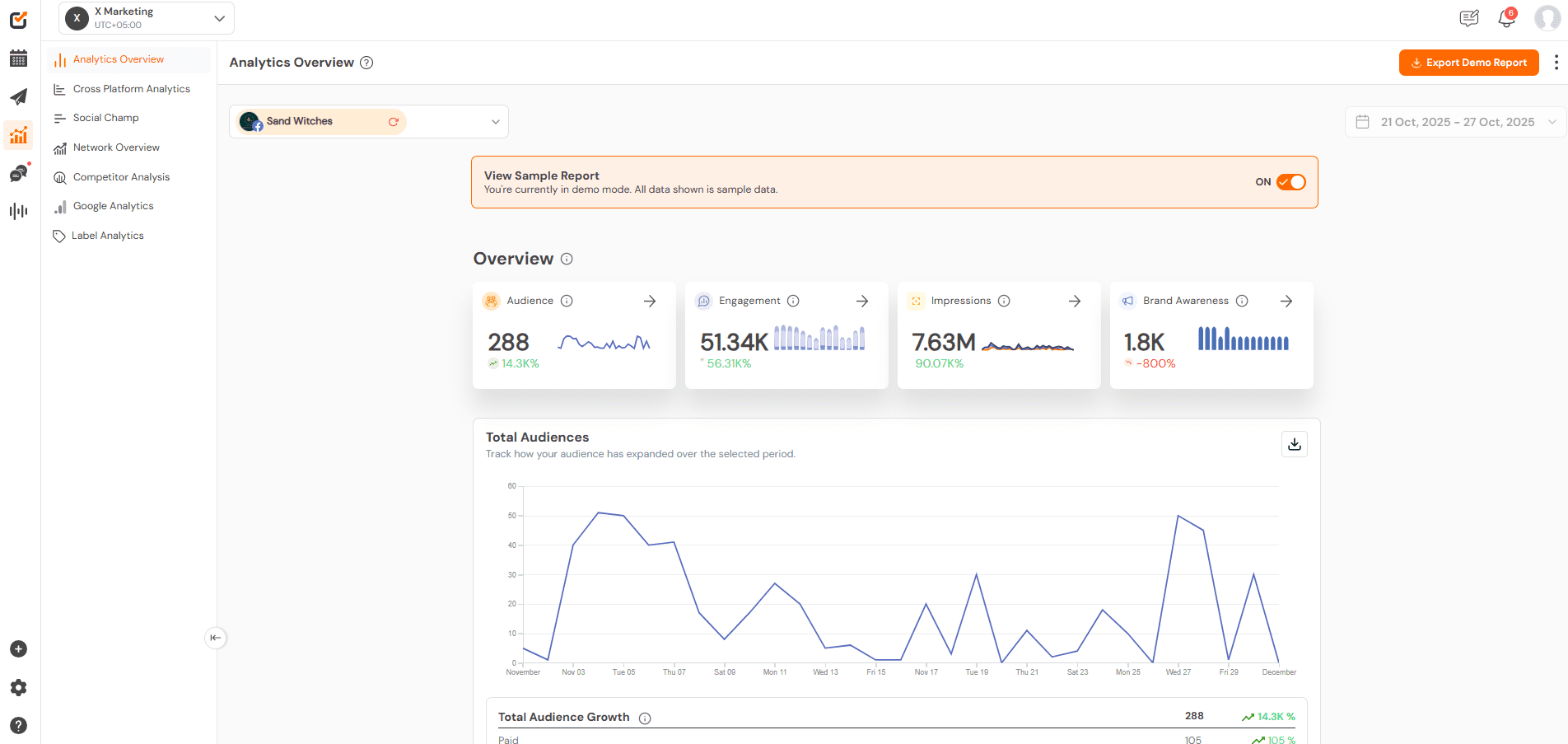According to research, 57% of Gen Z want to be influencers. And why not?
We all dream of traveling the world on a brand’s dime and driving the most expensive car in the world. And who says we can’t?
If a boy next door like Mr. Beast can make it big in the world of social media, so can we!
Short Summary
- 57% of Gen Z aspire to be influencers, and success depends on understanding how to measure social media performance effectively.
- You need to avoid chasing empty numbers, focus on actions that show genuine audience interest, such as shares, saves, and thoughtful comments.
- Set SMART goals (Specific, Measurable, Achievable, Relevant, Time-bound) that align with your business objectives to ensure social media efforts drive tangible results.
- Use insights to optimize strategy, amplify top-performing content, fix weak areas, and test new posting strategies.
- Choose Social Champ to be your all-in-one tool to track analytics, manage platforms, and measure performance efficiently.
But just dreaming big isn’t enough. You should know how to measure social media success at every step.
Because to reach those influencer goals, you need more than just a good following.
You need the right metrics to track your progress, tools to analyze your performance, and strategies to optimize your efforts.
So, in this blog, I’ll walk you through the metrics that matter, the tools you need to measure them, and strategies to drive ROI so you can turn your dreams into measurable success!
Are you ready?

If Yes, Then Try Social Champ Today!
It helps you track your social media performance across platforms, so that you can strategize your content and presence better! The discounts won’t last long, so try it now!
What Is Social Media Success? (Beyond Vanity Metrics)
For a long time, we all got caught up in what I call the “applause metrics”: Likes, Followers, and simple Views.
They’re like standing ovations, they feel great in the moment, but they don’t actually tell you if people bought a ticket to your next show, or even if they remember the name of the play!
Here’s what you need to do for measuring social media success:
-
Stop Chasing The Illusion
Think about it:
A post can get 10,000 likes, but if zero people click the link to your product page, did you actually succeed in business? Nope.
You can have 1 million followers, but if your comments section is dead silent and you’re getting zero inbound sales inquiries, you’re essentially broadcasting to an empty room.
So stop chasing views and meaningless comments because the algorithm has stopped doing that a long time ago.
It favors content that sparks meaningful engagement, i-e, shares, saves, and long comments.
-
Focus on Quality Engagement
If you want to hit your social media benchmarks, you need people to invest their time, not just their thumbs. The platforms reward you for this, too!
For example, when someone saves your content, they signal that it’s so useful they plan to come back to it.
This shows lasting value and tells the algorithm your content is “bookmark-worthy.”
Take Duolingo’s example from TikTok!
They don’t chase after views. They drive shares and mentions because their content is so hilarious and relatable to the TikTok audience.
@duolingodon’t look under your bed, you don’t know what you might find. ib: @Spencer Lackey #horror #scary #halloween #duolingo #fyp♬ original sound – Reich Salvatore Flores – WBT.kaiser -
Brand and Loyalty Is Your Long Game
Social media is your brand’s community hub, and real success is about building a loyal tribe that sticks with you for the long haul.
You need to use social listening tools to understand what people are saying about you when you’re not in the room (I mean virtually).
Also, don’t forget to reply to the comments on your posts. Social media is a key customer service channel, and helpful responses to DMs and comments drive loyalty and reduce churn.

Comment Section of an Instagram Post When people feel heard and helped, they become your most powerful advocates.
Featured Article: Top 10 Social Media Listening Tools
Setting Goals and KPIs for Social Media Success
The next step is to draw a straight line from your social media activity to those big-picture goals.
Here are some social media best practices that will help you set your goals:
-
Align Your Social Goals With Your Business Objectives
Before you write down a single social media goal, grab your company’s overall business goals.
Are you trying to boost online sales by 20% this quarter?
Is your main focus reducing customer support calls by improving self-service content?
Your social media must contribute to one of these core objectives. If it doesn’t, you’re just wasting time.
For example, let’s say your main business objective is “Lead Generation.”
If that’s the case, your primary social media goal cannot just be “Get more likes.”
A better-aligned goal would be: “Increase the number of qualified email sign-ups coming from LinkedIn ads by 15% this quarter.”
-
Make Your Goals SMART, Not Fuzzy
We all love the classic SMART framework because it works like a charm. It ensures your goals are precise enough to be tracked and realistic enough to be achieved.
- Specific: You need to define what you want to achieve clearly. Instead of “Improve customer service,” try: “Reduce the average response time for customer DMs on X (Twitter) by 50%.”
- Measurable: You have to be able to quantify it. You can’t measure “better engagement,” but you can measure a 10% increase in comment volume per post.
- Achievable: While it’s great to dream big, your goal should be realistic given your team and budget. If you currently get 10 clicks a month, aiming for 10,000 next month might lead to burnout. Aim for a challenging but possible 200% growth in clicks.
- Relevant: Does this goal matter to your overall business? Increasing followers on a platform your target audience doesn’t use is not relevant. Growing qualified traffic to your pricing page is relevant.
- Time-bound: Every goal needs a deadline. This creates urgency and accountability. Instead of “Increase sign-ups,” say: “Increase newsletter sign-ups from Instagram by 25% by the end of the next quarter (Q1).”
-
Define Your Key Performance Indicators (KPIs)
Once you have your SMART goal, you need the little numbers, your social media KPIs, that act as the checkpoints along the way.
Business Goal Social Media KPI (What You Track) Why It Matters (The “So What?”) Increase Brand Awareness Unique Reach, Share of Voice (SOV), Mentions. These metrics show how many new eyes saw your brand and how often your brand is being talked about versus competitors. Drive Product Sales/Revenue Conversion Rate from Social, Return on Ad Spend (ROAS). Did people click the link and buy the product? ROAS tells you if your social ad spending is profitable. Improve Customer Loyalty Social Media Response Rate/Time, Sentiment Score (Positive/Negative mentions). How quickly are you helping customers? Are their comments getting more positive over time? This builds trust! Generate Qualified Leads Click-Through Rate (CTR) to Landing Page, Cost Per Lead (CPL). CTR shows if your content is compelling enough to get the click, and CPL shows if you’re acquiring those leads affordably.
How To Measure Social Media Success?
Here’s a breakdown of the key metrics you should be tracking, grouped by what you’re actually trying to achieve.
Think of these categories as your report card for different parts of your social strategy!
Goal 1: Boosting Brand Awareness
If your main mission is to get your brand’s name, logo, or message in front of as many new eyes as possible, these are your star metrics:
- Reach & Impressions (The Visibility Check):
- Reach is the total number of unique people who saw your content. This tells you how wide your net is.
- Impressions is the total number of times your content was displayed. This number is often higher than Reach because one person might see your post multiple times.
- Significance: If your goal is awareness, a high reach means your content is successfully showing up in new feeds, which is exactly what you want!
- Follower/Audience Growth Rate (The Popularity Trend):
- This tracks how quickly you’re gaining new followers over a period of time.
- Significance: A steady, healthy growth rate (not just a huge spike from a single contest) indicates that your content is consistently attracting the right people to stick around.
- Social Share of Voice (The Industry Chatter):
- This compares how often your brand is mentioned on social media versus your competitors.
- Significance: It shows you if you’re dominating the conversation in your niche or if your competitors are drowning you out. If your Share of Voice is growing, your awareness is definitely winning!
Goal 2: Driving Audience Engagement & Community
If you want to build a loyal community that genuinely loves interacting with your brand, focus on metrics that show deep connection, not just a quick scroll-past:
- Engagement Rate (The Resonance Score):
- This calculates the percentage of people who saw your post and took an action (liked, commented, shared, or saved it).
- Significance: This is arguably the most important content quality metric. A high rate means your content is resonating and sparking a response. It tells the algorithm your stuff is good!
- Comments & Conversation Rate (The True Dialogue):
- Simply put, how many comments are you getting per post?
- Significance: A comment is a bigger commitment than a like! It shows your audience cares enough to weigh in, ask a question, or give feedback. The higher the number, the more of a conversation-starter your content is.
- Saves & Shares (The Value Vault):
- Saves mean people find your content so valuable that they want to refer back to it later (think recipes, tips, or great advice).
- Shares mean they love it so much they’ll risk their own reputation to pass it on to their friends.
- Significance: These actions are gold! They show your content is providing real value and acting as a powerful referral engine for your brand.
Goal 3: Generating Leads & Driving Sales (ROI)
For the metrics that show how your social media efforts are impacting your business’s bottom line:
- Click-Through Rate (CTR) (The Action Taker):
- This is the percentage of people who saw your post and clicked on the link you included (e.g., to your website, a product page, or a sign-up form).
- Significance: A high CTR proves your Call-to-Action (CTA) is compelling and your audience is motivated to leave the social platform and take the next step with your brand.
- Conversion Rate (The Cash Register):
- This tracks the percentage of people who, after clicking a link from social media, complete a specific desired action on your website (like making a purchase, filling out a form, or subscribing to a newsletter).
- Significance: This is the ultimate metric for proving your social media ROI! It directly connects your content to revenue or lead generation, which means you know your efforts are paying off.
- Cost Per Conversion (The Budget Check, for Paid Ads):
- If you’re running ads, this measures how much money it costs you to get one person to complete your desired action (e.g., how much you paid to get one new email subscriber).
- Significance: A low cost per conversion means your ad money is being spent efficiently, which makes your finance team very happy!
To be honest, I find this all way too hard, which is why I use a tool that makes it easier for me to measure social media engagement.
Social Champ’s Analytics saves you from learning how to measure social media success.
With its easy-to-use dashboard, you can check your social media insights and won’t have to learn to track your metrics manually.


Missing That One Piece? It’s in Your Analytics.
Find what your content’s been missing with Social Champ, timing, tone, or trend. Your data already knows the answer.
Benchmarking Your Social Media Success Against Competitors
Say your recent post on social media got 10,000 likes and a good reach, great news, right?
But what if your competitor got even better reach and 30,000 likes on their post? You’ll wonder how they got it right, won’t you?
That’s why competitor analysis is important. It tells you what your competitor’s strategy and audience looks like, so you can plan yours to give them a competition.
What a Competitor Analysis Reveals
You’re not just looking at their follower count; you’re dissecting their strategy.
Here are the three big takeaways you get from a good benchmark:
-
The Industry Engagement Standard
What is the average engagement rate for a brand in your niche?
If your main rival is getting a consistent 5% engagement rate on their Instagram Reels, and you’re stuck at 1%, you know exactly where you need to improve your content quality.
You now have a realistic, actionable goal to aim for.
-
Content That Really Works
By looking at your competitors’ top-performing posts, you discover the topics, formats (Is video dominating? Are infographics huge?), and tone that resonate most with your shared audience.
-
Untapped Opportunities
This is the best part!
You might find your competitors are crushing it on Facebook but completely ignoring the massive engagement on TikTok.
That gap is your chance to dominate a platform before they catch up.
Or, perhaps they never respond to customer service messages in their comments; that’s a golden opportunity for you to win loyal customers with stellar social listening and quick replies.
Featured Article: How to Manage Social Media in 2026?
Optimize and Refine Your Social Media Strategy for Ongoing Success
Measurement is only as good as what you do with the numbers!
You’ve put in the hard work: you’ve tracked your own performance and completed your competitive analysis.
Now you have a clear picture of what’s working, what’s missing, and what the industry standard looks like.
The next step is the most exciting one: optimizing and refining your strategy to drive real, ongoing success.
How to Turn Metrics into Momentum
Amplify Your Winners
Go back to your performance report and identify the top 10% of your content (posts with the highest Engagement Rate, CTR, or Saves).
- What made them great? Was it the format (a quick Reel vs. a long photo caption)? Was it the topic (a ‘how-to’ guide vs. a ‘behind-the-scenes’ look)?
- Action: Double down on these winning ingredients! Create more content in those exact formats, covering similar successful topics. If your audience loved a funny video, make another one!
Fix Your Weaknesses
Review the content that performed poorly or the areas where your competitors outperformed you (e.g., lower reach, poor response time).
- Action: If your Click-Through Rate (CTR) is low, the problem isn’t the content itself; it’s the Call-to-Action (CTA). Experiment with clearer, more urgent language in your captions to motivate the click. If your response time is slow, dedicate specific time slots each day to address comments and DMs to improve your customer service metric.
Test and Learn (The A/B Approach)
Social media success is about continuous testing. Use your analysis to formulate a clear hypothesis, test it, and track the results.
- Example Hypothesis: “Our competitors post their highest-engagement content between 11 AM and 1 PM. If we test that posting window, our Reach will increase by 15%.”
- Action: Run the test for a month, track the data, and if it works, that becomes your new optimal posting time!
In my opinion, all of this becomes very convenient if you use social media optimization tools for it. Measuring social media success is a tough nut to crack, especially if you’re new!
Which is why I rely on Social Champ. It gives me insights into how my content is performing on each platform, and it supports 11+ social networks, so I don’t have to switch tabs.

All I have to do is log in to my Social Champ account, schedule my posts, and let it measure my social media success.

You Can Also Have It!
Sign up for a free trial now and start using Social Champ to measure your social media success. You won’t need another tool after this!
Conclusion
You have it now, your answer to how to measure social media success!
I don’t expect you to be a champion at this from the start, and you shouldn’t either. Practice makes perfect, and you will learn it with time.
However, having a social media marketing strategy and relying on a management tool for implementation can definitely speed up the process and help you analyze the data better.
So, don’t wait anymore and start measuring your social media success without wasting time on meaningless content again!





